TOYOTA PRIUS PLUG-IN 2013 Owners Manual
Manufacturer: TOYOTA, Model Year: 2013, Model line: PRIUS PLUG-IN, Model: TOYOTA PRIUS PLUG-IN 2013Pages: 704, PDF Size: 19.59 MB
Page 371 of 704
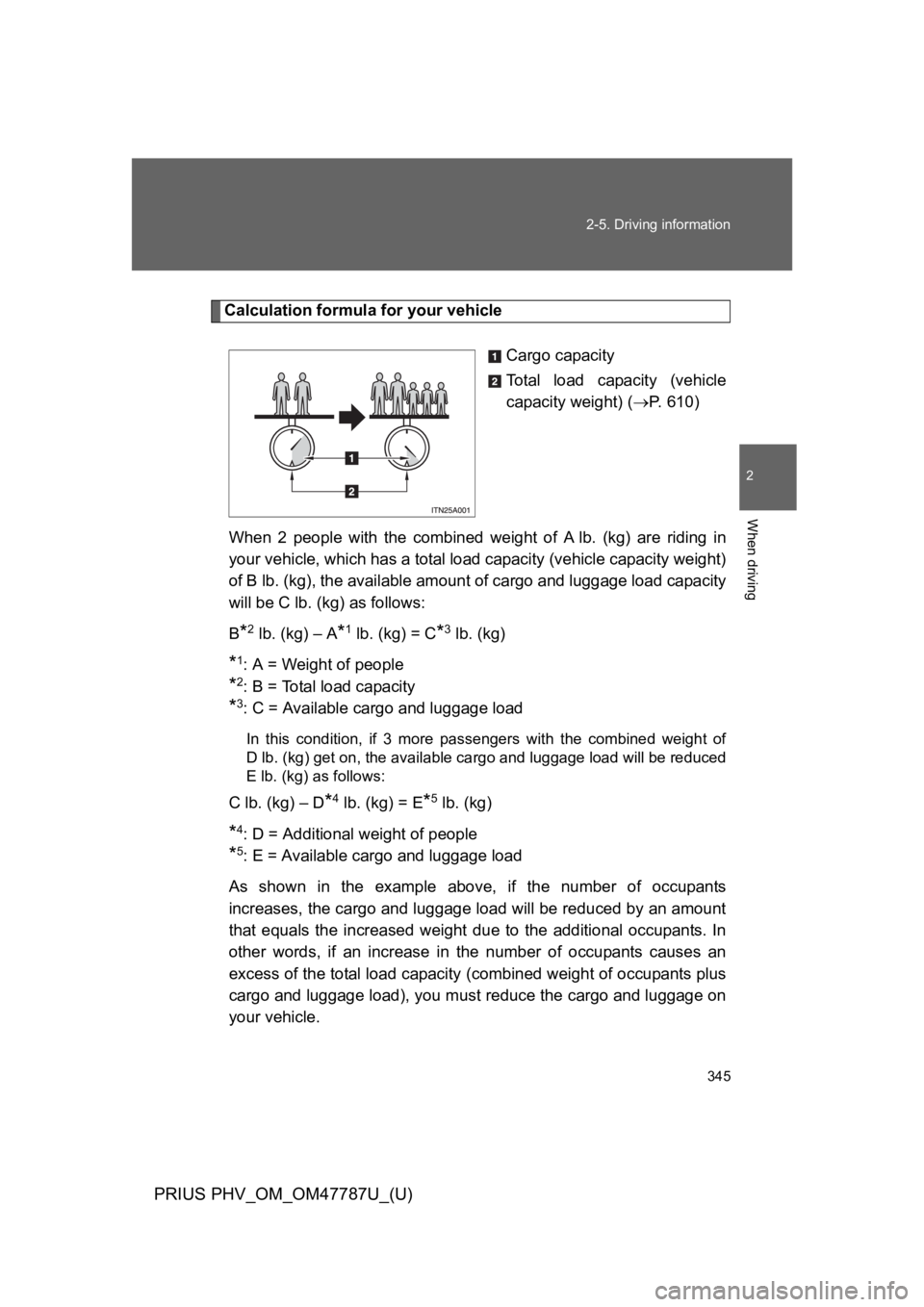
345
2-5. Driving information
PRIUS PHV_OM_OM47787U_(U)
2
When driving
Calculation formula for your vehicle
Cargo capacity
To t a l l o a d c a p a c i t y ( v e h i c l e
capacity weight) (→P. 6 1 0 )
When 2 people with the combined weight of A lb. (kg) are riding in
your vehicle, which has a total load capacity (vehicle capacity weight)
of B lb. (kg), the available amount of cargo and luggage load capacity
will be C lb. (kg) as follows:
B*2 lb. (kg) – A*1 lb. (kg) = C*3 lb. (kg)
*1: A = Weight of people
*2: B = Total load capacity
*3: C = Available cargo and luggage load
In this condition, if 3 more passengers with the combined weight of
Dlb. (kg) get on, the available cargo and luggage load will be reduced
E lb. (kg) as follows:
C lb. (kg) – D*4 lb. (kg) = E*5 lb. (kg)
*4: D = Additional weight of people
*5: E = Available cargo and luggage load
As shown in the example above, if the number of occupants
increases, the cargo and luggage load will be reduced by an amount
that equals the increased weight due to the additional occupants. In
other words, if an increase in the number of occupants causes an
excess of the total load capacity (combined weight of occupants plus
cargo and luggage load), you must reduce the cargo and luggage on
your vehicle.
Page 372 of 704

346
2-5. Driving information
PRIUS PHV_OM_OM47787U_(U)
CAUTION
■Things that must not be carried in the luggage compartment
The following things may cause a fire if loaded in the luggage compart-
ment:
●Receptacles containing gasoline
●Aerosol cans
■Storage precautions
Observe the following precautions.
Failure to do so may result in death or serious injury.
●Stow carg o and luggage in the luggage compar tment whenever possi-
ble.
●Do not stack cargo and luggage in the luggage compartment higher
than the seatbacks.
Such items may be thrown about and possibly injure people in the
vehicle in the event of sudden braking or in an accident.
●Do not place cargo or luggage in or on the following locations as the
item may get under the brake or accelerator pedal and prevent the
pedals from being depressed properly, block the driver’s vision, or hit
the driver or passengers, causing an accident:
•At the feet of the driver
•On the front passenger or rear seats (when stacking items)
•On the luggage cover
•On the instrument panel
•On the dashboard
Page 373 of 704
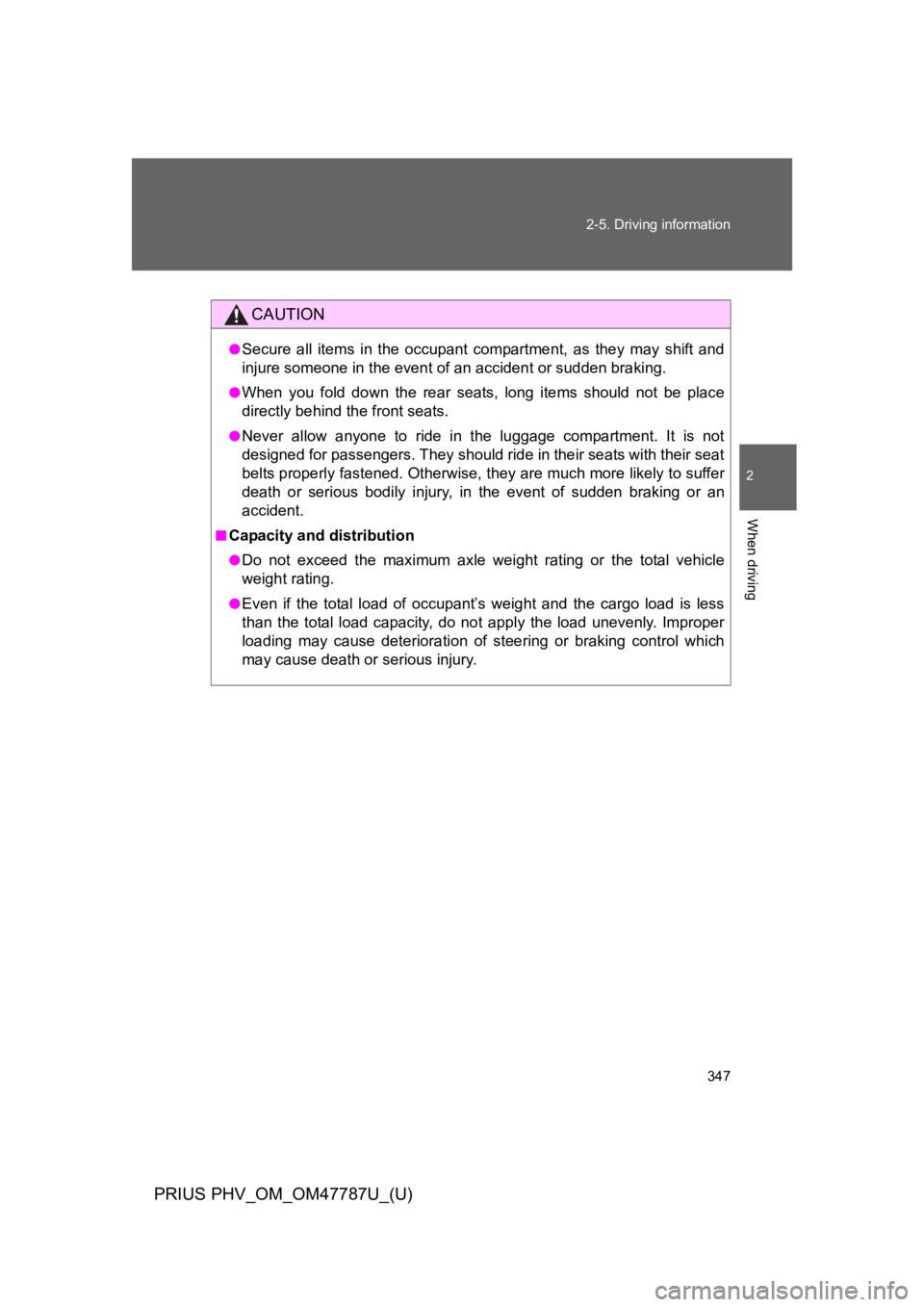
347
2-5. Driving information
PRIUS PHV_OM_OM47787U_(U)
2
When driving
CAUTION
●Secure all items in the occupant compartment, as they may shift and
injure someone in the event of an accident or sudden braking.
●When you fold down the rear seats, long items should not be place
directly behind the front seats.
●Never allow anyone to ride in the luggage compartment. It is not
designed for passengers. They should ride in their seats with their seat
belts properly fastened. Otherwise, they are much more likely to suffer
death or serious bodily injury, in the event of sudden braking or an
accident.
■Capacity and distribution
●Do not exceed the maximum axle weight rating or the total vehicle
weight rating.
●Even if the total load of occupant’s weight and the cargo load is less
than the total load capacity, do not apply the load unevenly. Improper
loading may cause deterioration of steering or braking control which
may cause death or serious injury.
Page 374 of 704
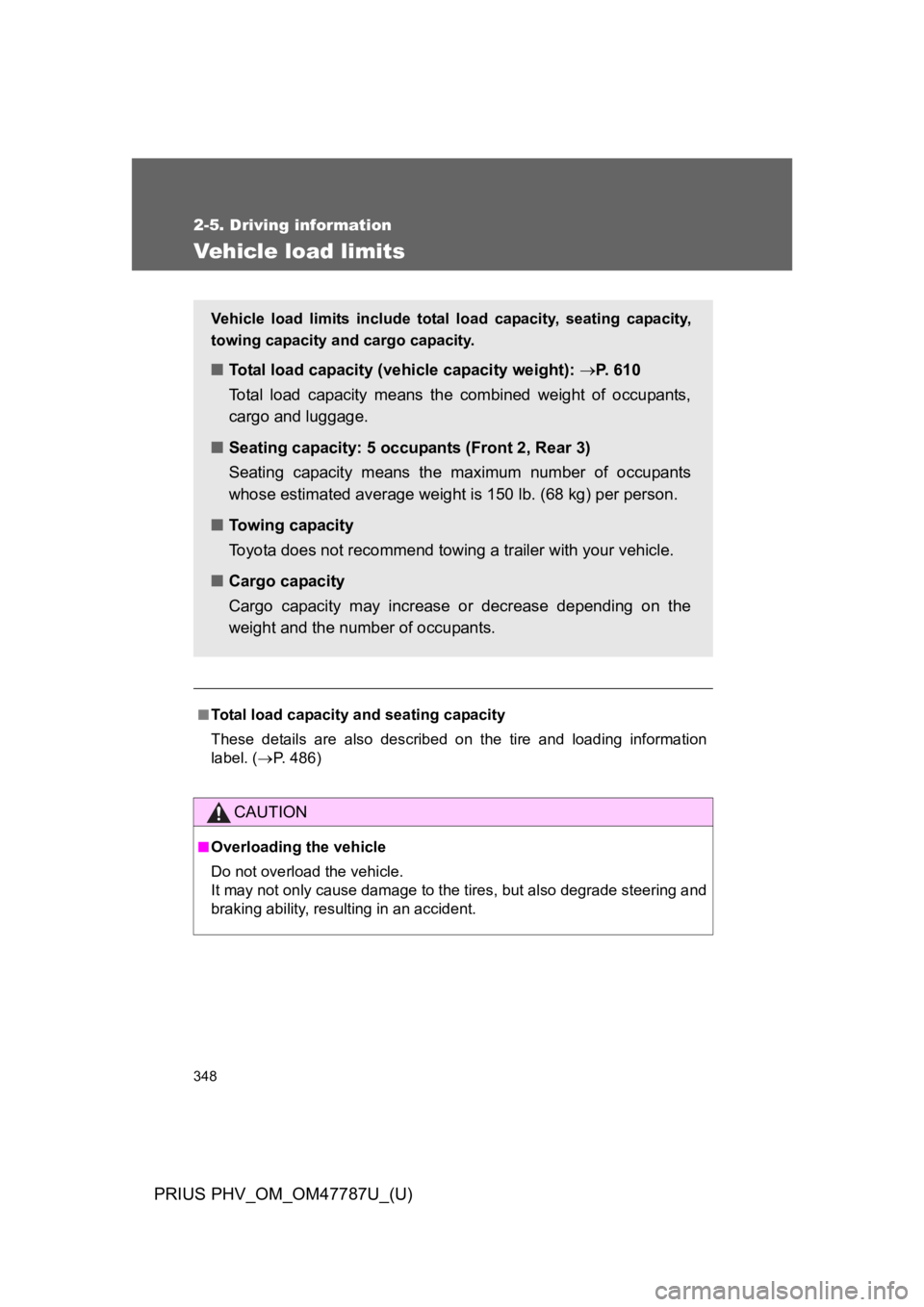
348
2-5. Driving information
PRIUS PHV_OM_OM47787U_(U)
Ve h i cl e l o a d l i m i t s
■To ta l l o a d c a pa c i t y a n d s e a t i n g c a pa c i t y
These details are also described on the tire and loading information
label. (→P. 4 8 6 )
CAUTION
■Overloading the vehicle
Do not overload the vehicle.
It may not only cause damage to the tires, but also degrade steering and
braking ability, resulting in an accident.
Ve h i c l e l oa d l i m i ts i n c l u d e t o ta l l o a d c a pa c i t y, s e a t i ng c a pa c i t y,
towing capacity and cargo capacity.
■To ta l l o a d c a pa c i t y ( v e h i c l e c a pa c i t y w e i g h t ) : →P. 6 1 0
To t a l l o a d c a p a c i t y m e a n s t h e c o m b i n e d w e i g h t o f o c c u p a n t s ,
cargo and luggage.
■Seating capacity: 5 occupants (Front 2, Rear 3)
Seating capacity means the maximum number of occupants
whose estimated average weight is 150 lb. (68 kg) per person.
■To w i n g c a pa c i t y
To y o t a d o e s n o t r e c o m m e n d t o w i n g a t r a i l e r w i t h y o u r v e h i c l e .
■Cargo capacity
Cargo capacity may increase or decrease depending on the
weight and the number of occupants.
Page 375 of 704
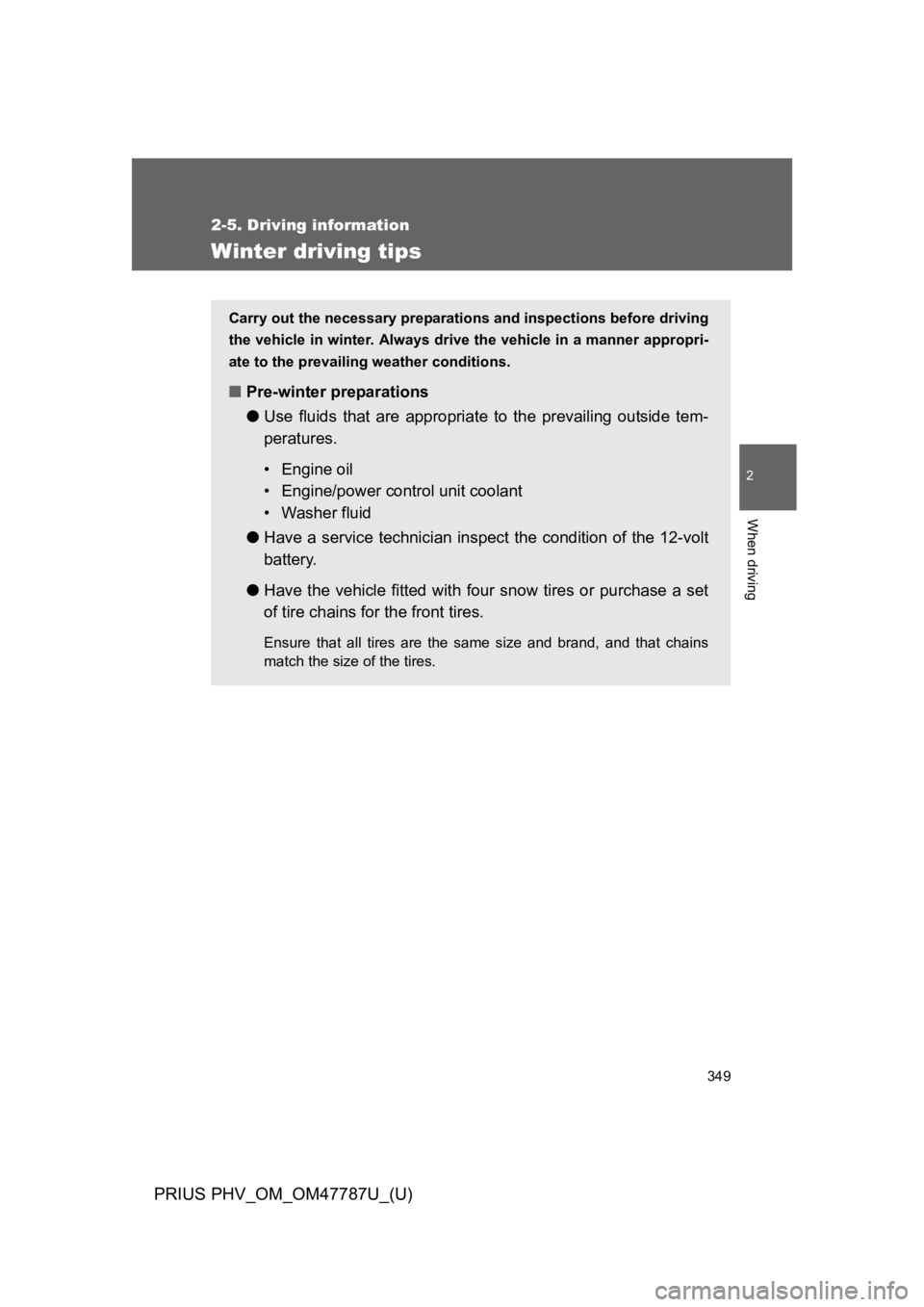
349
2-5. Driving information
PRIUS PHV_OM_OM47787U_(U)
2
When driving
Winter driving tips
Carry out the necessary preparations and inspections before driving
the vehicle in winter. Always drive the vehicle in a manner appropri-
ate to the prevailing weather conditions.
■Pre-winter preparations
●Use fluids that are appropriate to the prevailing outside tem-
peratures.
•Engine oil
•Engine/power control unit coolant
•Washer fluid
●Have a service technician inspect the condition of the 12-volt
battery.
●Have the vehicle fitted with four snow tires or purchase a set
of tire chains for the front tires.
Ensure that all tires are the same size and brand, and that chains
match the size of the tires.
Page 376 of 704
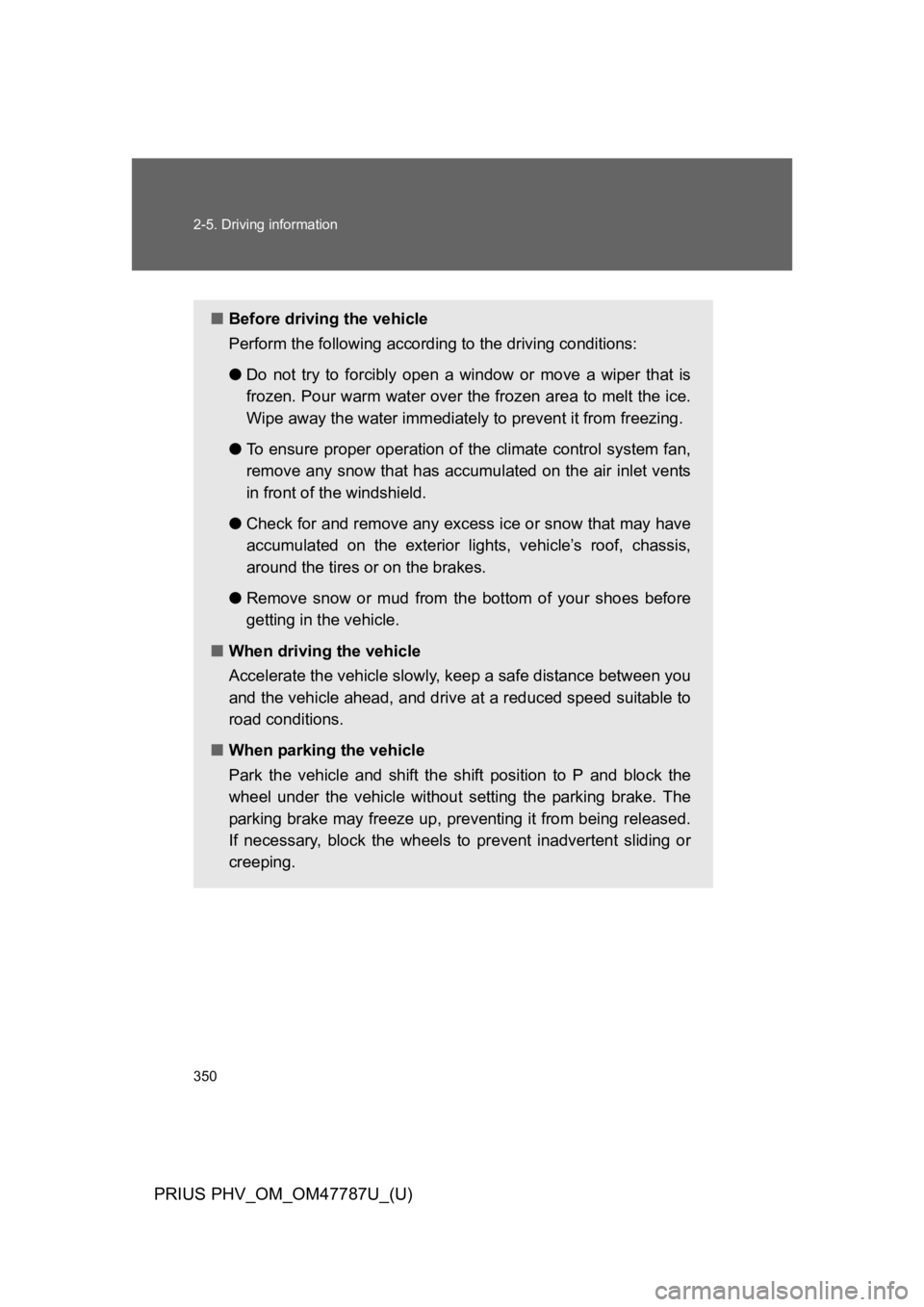
350
2-5. Driving information
PRIUS PHV_OM_OM47787U_(U)
■Before driving the vehicle
Perform the following according to the driving conditions:
●Do not try to forcibly open a window or move a wiper that is
frozen. Pour warm water over the frozen area to melt the ice.
Wipe away the water immediately to prevent it from freezing.
●To e n s u r e p r o p e r o p e r a t i o n o f t he climate control system fan,
remove any snow that has accumulated on the air inlet vents
in front of the windshield.
●Check for and remove any excess ice or snow that may have
accumulated on the exterior lights, vehicle’s roof, chassis,
around the tires or on the brakes.
●Remove snow or mud from the bottom of your shoes before
getting in the vehicle.
■When driving the vehicle
Accelerate the vehicle slowly, keep a safe distance between you
and the vehicle ahead, and drive at a reduced speed suitable to
road conditions.
■When parking the vehicle
Park the vehicle and shift the shift position to P and block the
wheel under the vehicle without setting the parking brake. The
parking brake may freeze up, preventing it from being released.
If necessary, block the wheels to prevent inadvertent sliding or
creeping.
Page 377 of 704

351
2-5. Driving information
PRIUS PHV_OM_OM47787U_(U)
2
When driving
Selecting tire chains
Use the tire chains of correct size and type.
Use SAE Class “S” type radial tire chains except radial cable chains
or V-bar type chains.
Regulations on the use of tire chains
Regulations regarding the use of tire chains vary depending on loca-
tion and type of road. Always check local regulations before installing
chains.
■Tire chain installation
Observe the following precautions when installing and removing chains:
●Install and remove tire chains in a safe location.
●Install tire chains on the front tires only. Do not install tire chains on the
rear tires.
●Install tire chains on front tires as tightly as possible. Retighten chains
after driving 1/4 - 1/2 mile (0.5 - 1.0 km).
●Install tire chains following the instructions provided with the tire chains.
Page 378 of 704
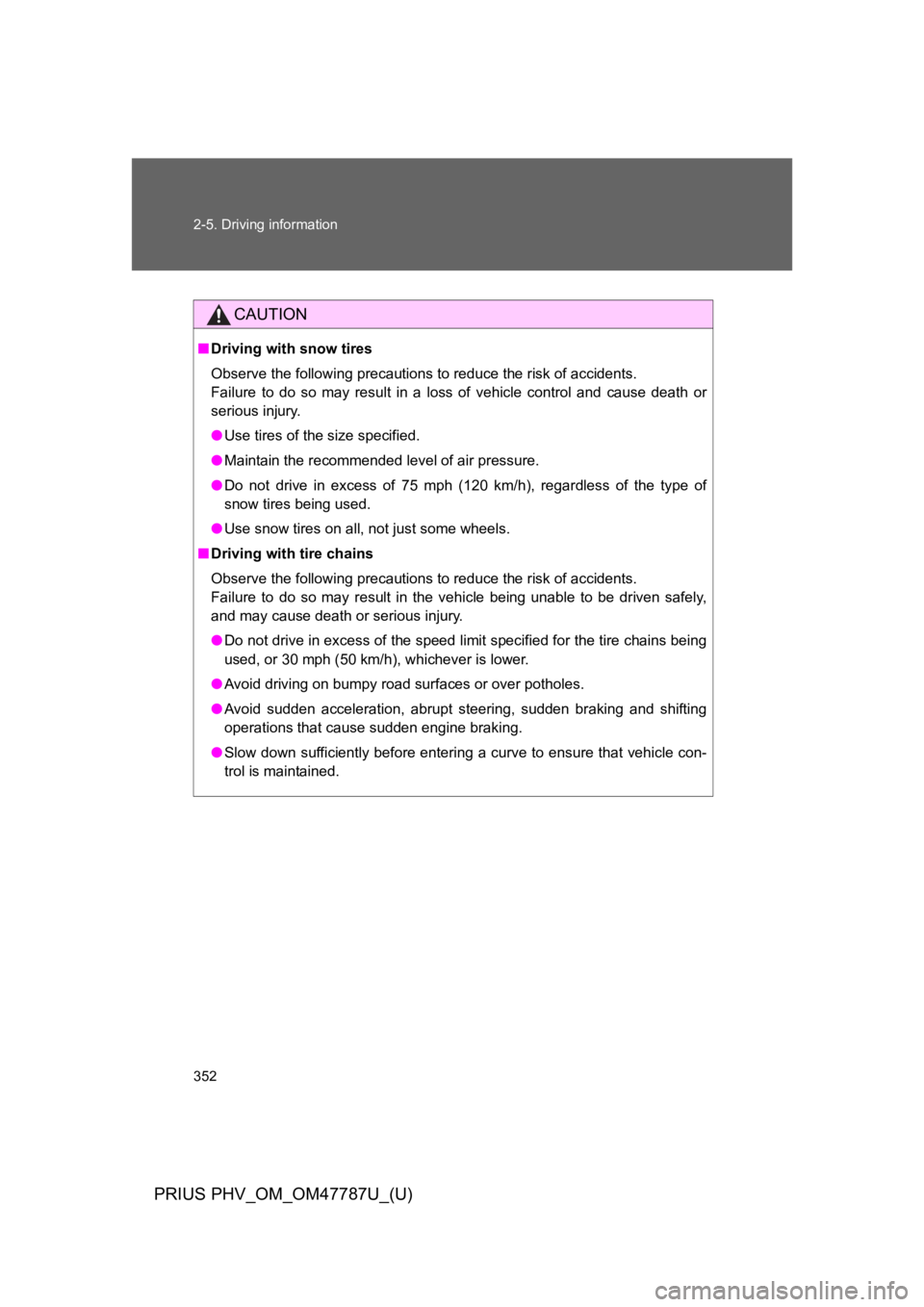
352
2-5. Driving information
PRIUS PHV_OM_OM47787U_(U)
CAUTION
■Driving with snow tires
Observe the following precautions to reduce the risk of accidents.
Failure to do so may result in a loss of vehicle control and cause death or
serious injury.
●Use tires of the size specified.
●Maintain the recommended level of air pressure.
●Do not drive in excess of 75 mph (120 km/h), regardless of the type of
snow tires being used.
●Use snow tires on all, not just some wheels.
■Driving with tire chains
Observe the following precautions to reduce the risk of accidents.
Failure to do so may result in the vehicle being unable to be driven safely,
and may cause death or serious injury.
●Do not drive in excess of the speed limit specified for the tire chains being
used, or 30 mph (50 km/h), whichever is lower.
●Avoid driving on bumpy road surfaces or over potholes.
●Avoid sudden acceleration, abrupt steering, sudden braking and shifting
operations that cause sudden engine braking.
●Slow down sufficiently before entering a curve to ensure that vehicle con-
trol is maintained.
Page 379 of 704

353
2-5. Driving information
PRIUS PHV_OM_OM47787U_(U)
2
When driving
NOTICE
■Repairing or replacing snow tires
Request repairs or replacement of snow tires from Toyota dealers or legiti-
mate tire retailers.
This is because the removal and attachment of snow tires affects the opera-
tion of the tire pressure warning valves and transmitters.
■Fitting tire chains
The tire pressure warning valves and transmitters may not function correctly
when tire chains are fitted.
Page 380 of 704
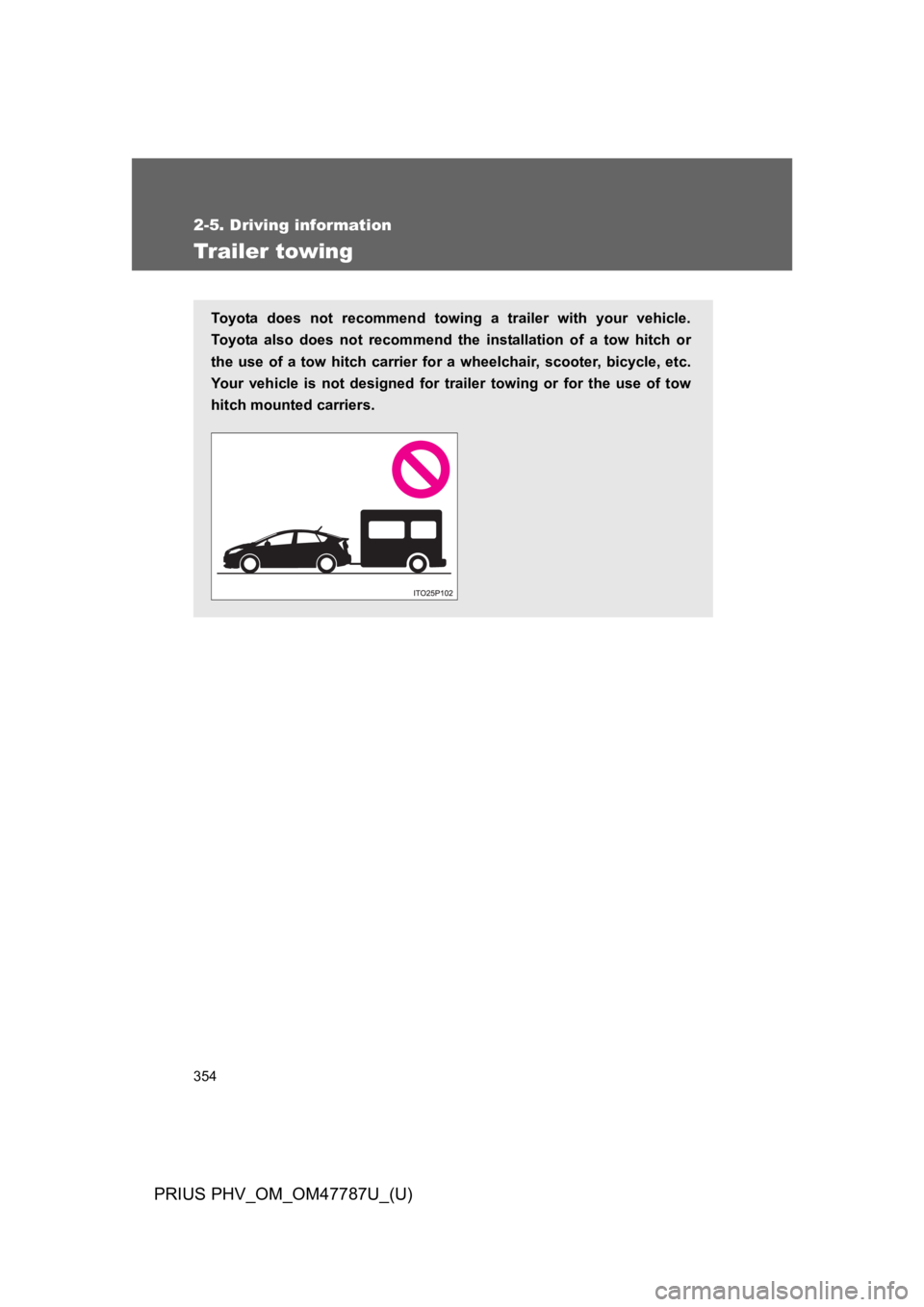
354
2-5. Driving information
PRIUS PHV_OM_OM47787U_(U)
Tr ailer towing
To y o ta d o e s n o t r e c o m m e n d t o w i n g a trailer with your vehicle.
To y o ta a l s o d o e s n o t r e c o m m e n d t h e i n s ta l l a t i o n o f a t o w h i t c h o r
the use of a tow hitch carrier for a wheelchair, scooter, bicycle, etc.
Yo u r v e h i c l e i s n o t d e s i g n e d f o r t railer towing or for the use of tow
hitch mounted carriers.